Common Fall Garden Pests and How to Bring Control
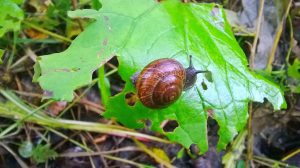
Garden insect pests can be a real nuisance as they invade our gardens making a meal out of our garden plants and what makes matters worse is that many of them have been known to carry and spread diseases. These garden pests can turn a dream garden into a nightmare causing healthy beautiful plants to become an eyesore if action is not taken immediately.
The good news, however, is through early and proper identification we can strike back putting an end to their reign, I have had to deal with such garden pests on many occasions bringing control through proper and effective practices that worked wonders. Below we will be discussing fall garden pests in South Florida and how to bring control.
Winning the War on Fall Garden Pests
We have come too far (spring through summer) and worked so hard in our gardens to let those uninvited guests (garden insect pests) take over our landscapes and gardens. Many years ago I was a foreman on a 2-acre estate (landscape) that was beautifully maintained. My crew and I did our best to ensure that the gardens retained their beauty and luster but one common garden pest that was a real challenge was snails.
These garden pests seem to be everywhere especially during the early morning hours when I arrived to work, I tried handpicking them (mechanical control) which is a safe and effective way without applying chemicals. This method would have worked if the snail population was small but because their presence was such in great numbers snail bait was brought in to bring quick control.
Affiliate Disclaimer
temp-gardenofedengardencenter.siterubix.com is a participant in the Amazon Services LLC Associates Program, an affiliate advertising program designed to provide a means for sites to earn advertising fees by advertising and linking to Amazon properties including, but not limited to, amazon.com. Amazon offers a small commission on products sold through its affiliate links.
6 Fall Garden Pests in your South Florida Garden
Besides snails, we will be looking at how to control at least 6 fall garden pests and how to bring control or reduce their population so that they won’t be a threat to our gardens and landscapes.
- Cabbage Worms
- Corn Earworms
- Cucumber Beetles
- Cabbage Loopers
- Stink Bugs
- Aphids
A cabbage worm
Cabbage Worms– The female lays her eggs on the leaves’ underside, the eggs resemble tiny green footballs. The baby worm-like caterpillars are 1-inch long and are covered in fine hairs that give the appearance of velvet. Pale yellow lines run lengthwise down their body, signs of this garden pest include holes in the flower stock or leaves, the plant leaves are also skeletonized. Dark green round pelleted excrement which is known as frass can be seen as well, The use of Bacillus thuringiensis will bring control, before applying however read and follow the manufactures direction for best results.
Corn Earworms– Corn worms love tomatoes and sweet corn as the name depicts, these garden pests can be easily identified by olive-gray to dusty brown, each forewing has a dark spot with the hind wings having dark bands across pale wings. The larvae grow up to 2 inches long and have thorny microspines, the larvae vary in color from pink to brown, yellow, and green.
Corns that are infected have damaged tips, if you pull back the husks you will find chewed kernels, if the corn is left unchecked the worm will eat through the husks. With tomatoes, corn earworms will make holes as they (corn earworm) chew through them.
Control measures include the use of cyhalothrin, permethrin, bifenthrin, carbaryl (Sevin), cyfluthrin, or esfenvalerate. Before applying chemicals read and follow the manufactures directions for the best results.
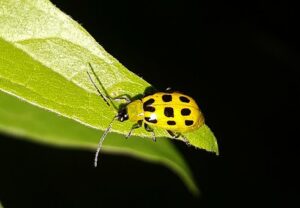
Cucumber Beetles-Pumpkins, cucumbers, and squash are favorites of this garden pest, the cucumber beetle hides under debris and leaves. The adult beetle is yellowish-to-green in color with a dark head, legs, and antennae, depending on the species they have distinctive stripes or spots that are black on their wings. The larvae of these beetles are creamy white and wormlike with slightly darker heads and tips.
Signs that these insects are present in your garden are leaves with holes, stunted plants, leaves that wilt and turn yellow, or leaves that have an unnatural form along with stunted fruits. To bring control use Sevin Killer Dust, Sevin insect killer, or Sevin insect kill Concentrate, before applying insecticides read and follow the manufacturer’s directions for the best results. Because the adult beetle overwinters in weeds, it’s best to keep the surrounding areas along with your garden free of weeds and long grasses.
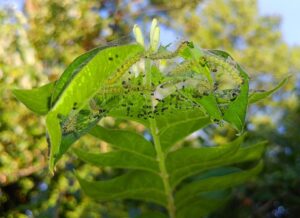
Fall Webworm– These worms can be identified by a tan or yellowish color, are hairy and up to 1 inch long, also look for a silken tent that is gray and loose spun by a group of caterpillars feeding on the leaves at the end of the branch. Signs of their presence are leaves that are eaten taking away from the beauty of garden plants, webbing of these garden pests can also be seen.
These worms rarely do serious damage to trees, in most cases, the trees will regrow their leaves back the following spring, fall webworms can be controlled with either Bacillus thuringiesis (Bt), Carbaryl, and pyrethroid insecticides such as esfenvalerate, cyfluthrin, per-methrin, and bifenthrin. Before using insecticides read and follow the manufacturer’s directions for the best results.
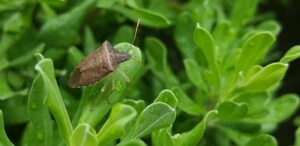
Stink Bugs– are also known to be destructive, these garden pests hang out on the sunny side of houses because of the warmth, they feed on vegetables and fruits and may be found in great numbers under pumpkins and squash. Once the colder months approach they will seek shelter (in your home) indoors to overwinter and will emerge once the warmer months (spring) return.
All stink bug species have a shield shape with some having more of a triangular shape in appearance while others appear to be more rounded, the adult beetle is between 1/3 to ¾ inch long. These bugs have one pair of segmented antennae, two pairs of overlapping wings, and three pairs of legs.
Stink bugs cause damage to fruit trees, ornamental plants, and other garden plants, these bugs do not cause structural damage to homes nor do they bite humans. These bugs however will release a foul-smelling chemical to keep predators at bay or to avoid them. Control measures include companion planting or installing garlic, thyme, radishes, catnip, marigold, lavender, or chrysanthemum among your garden plants.
Keep your garden and the surrounding area free of debris, to keep these bugs from entering your home seal all cracks and crevices, screens, and vents in attics and crawl spaces can be protected with a screen. Cracks around windows and doors can be sealed with caulk.
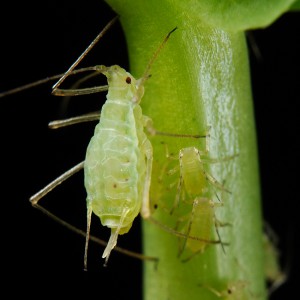
Aphids– Aphids are pear-shaped tiny insects that can either be light green, white, yellow, grey, or brown in color, these garden pests love the new or young tender growth of garden plants. Aphids cause damage by piercing garden plants and extracting or sucking the plant’s fluids or juice, infected plant leaves are discolored, stunted, curled, and will drop off from plants.
Aphids secret a sugary substance known as honeydew in which a black mass (Sooty mold) forms on the leaves causing the plant to look sickly and unattractive. In severe cases, sooty mold may also spread to the stems and branches. Besides the appearance of sooty mold ants is seen in great numbers and the reason for this is that ants are attracted by the honeydew that is sweet and sugary.
The nymphs or the young are greenish but turn yellow as they mature, a strong spray of water from a garden hose will knock them off bringing elimination, the use of insecticidal soap or horticultural oil will also bring control. Before applying pesticides, however, read and follow the manufacturer’s directions for the best results.
Bonus Just for You
Besides garden insect pests keep a look out for these fungal diseases that can also cause garden plants to lose their beauty and luster.
- Powdery Mildew
- Plant Rust
- Black Spot
Powdery Mildew– During the cool, wet weather garden plants can fall victim to this fungal disease, powdery mildew appears as a white powdery substance on the plant’s leaves. Small brown or pale irregular marks may also appear on the petal. The use of a fungicide or mixing 1 teaspoon of baking soda in 1 quart of water stir or shake well and add to a 32 oz spray bottle. When spraying ensure that the solution comes out mist, spray the plant thoroughly by getting full coverage of both the top and underside of the leaves. Spray the stems as well if powdery mildew spreads to this area.
Plant Rust– This disease is encouraged by weathers that are cold, mild, and damp, the spores are spread by water or the wind, signs include tiny raised specks on the leaves that are rust coloring, yellow, purple, brown, orange, or red. To bring control stop overhead irrigation or watering, instead, use a drip irrigation system. Watering your flowering plants early in the morning so they can be dried by the sun’s rays will help, applying neem oil or a weekly dusting of sulfur or the use of commercial fungicides will bring control. Before applying chemicals read and follow the manufacturer’s directions for the best results.
Black Spot– Black spot is a fungal disease that appears as black splodges on the upper part of the leaves or the leaves’ surface, this disease have be known to cause the yellowing of plant leave’s and even leaf drop. Control measures include the use of GardenTech® brand’s Daconil® fungicides, before applying fungicides read and follow the manufactures direction for the best results.
The final word on fall garden pests in South Florida
As you have seen from what we have discussed control is possible it’s all a matter of identifying them at the first sign of plant decline followed by applying the proper control methods. Why should our garden and landscape plants suffer at the hands of these garden pests? With the information that was shared, I encourage you to strike back as you seek to win the war on these garden pests that have no place in our gardens.
About the author
Norman loves being in the garden, both at home and for his job....
he is 'Natures Little helper' being outdoors, growing his vegetables and flowers from an early age.
Now having spent over 22 years in the profession he want to give some of his knowledge to others...
his vast array of hints and tips you will find scattered over this site will help you no end growing plants in your garden.

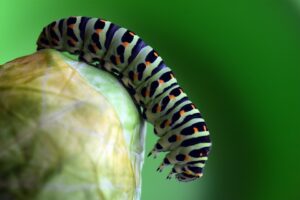
Thank you for this interesting article. It’s useful to know that different types of pests require specialised treatments – there is no ‘one size fits all’.
In the UK we have had a lot of whitefly swarming around. I’ve never seen them before – do you think it’s related to climate change?
It may be possible because of climate change, I remembered many years ago we had a serious outbreak as well with whiteflies, control measures were taken and now we have not had that issue since. Hope this helps, all the best to you, and have a good day!
I had no idea bug were that bad in the fall in Florida. I am not from the South Florida area and would like to get a small garden going with say tomatoes, corn, and potatoes. What kind of pests would I mainly have to look out for and what would you recommend to use in keeping them away?
Here are a few posts you can look at for your answer, hop this helps. https://gardenofedengardencent…, https://gardenofedengardencent…, https://gardenofedengardencent…
Unwanted pests and insects in the garden can indeed reek havoc with trying to grow vegetables or maintaining healthy looking plants. We are growing many of our own veggies and fruit and want to be as natural and organic as possible. Which can be a challenge on occasion.
Are any of the insecticides and treatments that you mention organic or natural? We sometime spray with copper sulphate, as long as it is a minimum of 3 weeks before harvesting. But can you suggest something else? Thank you
There are so many brands on the market but here are just a few, Bonide (BND857) Pyrethrin Garden Insect Spray Mix, Best Botanical, Plantonix Organic Neem Bliss 100% Neem Seed Oil, Diatomaceous Earth, and Horticultural Oil. As said earlier these are just a few of the many brands that you can try. Hope this helps and all the best to you.